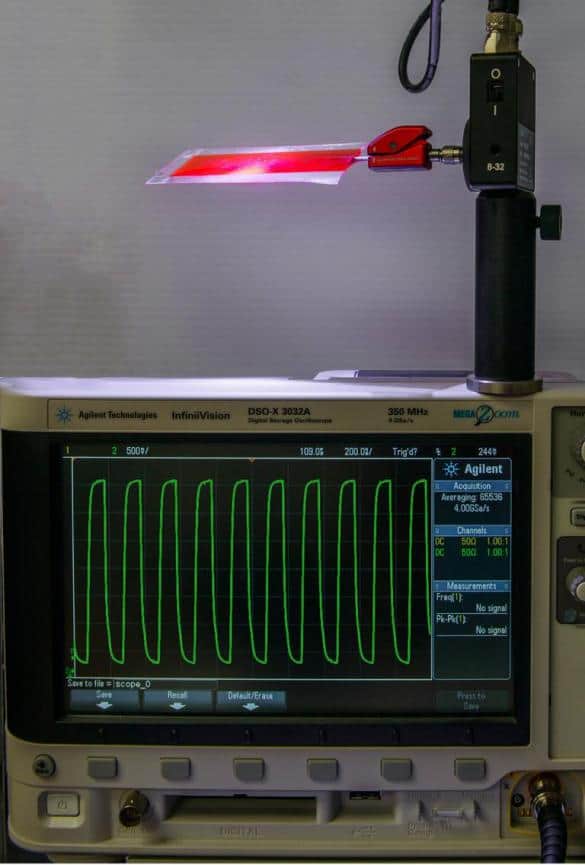 Fiber-coupled luminescent concentrators, using UbiQD quantum dots, deployed over a row of tomatoes in a commercial hydroponic greenhouse. Inset: Close-up of the fiber tips, where light is delivered to the lower canopy. Courtesy/UbiQD, Inc.
Fiber-coupled luminescent concentrators, using UbiQD quantum dots, deployed over a row of tomatoes in a commercial hydroponic greenhouse. Inset: Close-up of the fiber tips, where light is delivered to the lower canopy. Courtesy/UbiQD, Inc.
 Representation of spectral tissue sensing utilizing the quantum dot-enabled fiber-coupled broadband medical light-source. The reflected spectrum can be a disease diagnostic. Courtesy/UbiQD, Inc.
Representation of spectral tissue sensing utilizing the quantum dot-enabled fiber-coupled broadband medical light-source. The reflected spectrum can be a disease diagnostic. Courtesy/UbiQD, Inc.
UbiQD News:
- Wide-ranging applications include greenhouse agriculture, medical diagnostics, and telecommunications
UbiQD, Inc., a New Mexico-based nanotechnology development company, announced today an optical fiber-coupled luminescent concentrator technology that provides a new tool for optimizing light in controlled environments, enabling light-guiding to future UbiGro™ spectrum-control greenhouse products.
As recently highlighted in a paper published in the peer-reviewed journal, ACS Nano, the novel technology also offers other use cases, including significant impacts on speed and bandwidth of free-space telecommunication systems, and cancer diagnostics.
“We continue to push the envelope with light optimization in greenhouses,” said Dr. Hunter McDaniel, CEO of UbiQD. “One exciting potential use case is in vertical farming, where you could use our quantum dot-based luminescent fibers to harvest sunlight and optimally transmit that energy to multiple layers of plants, reducing or perhaps eliminating the need for expensive artificial lighting. It might also be useful in a lunar greenhouse.” In 2018 the company was awarded a contract by NASA to develop films for tailoring the spectrum of sunlight on long-duration space missions.
Each greenhouse ‘concentrator device,’ is capable of absorbing underutilized portions of sunlight, converting the energy to an ideal spectrum, and then strategically guiding that light to the lower leaves of the plant, which typically receive significantly less natural light due to shading. This methodology boosted the tomato yield in a commercial hydroponic greenhouse by 7% (fresh weight).
By utilizing UbiQD’s range of quantum dot colors, covering visible-to-NIR spectral regions, the company also demonstrated a low-cost, miniature broadband medical light source. Integrated into a spectral tissue sensing system, this could enable a real-time cancer test. Additionally, the device can operate as a free space (unfocused) detector in telecommunications or remote sensing, such as LIDAR, for discerning low-power signals.
Read more about this work in ACS Nano (https://doi.org/10.1021/acsnano.9b03335).
About UbiQD, Inc.
UbiQD is a nanotechnology company based in Los Alamos, New Mexico that manufactures safe, high-performance, quantum dots and greenhouse materials. The company uniquely focuses on sustainability applications that utilize its nanomaterials to manipulate sunlight. Licensing technology developed at Los Alamos National Laboratory, Massachusetts Institute of Technology, the University of Washington, and Western Washington University, UbiQD envisions a future where quantum dots are ubiquitous in a wide spectrum of applications. For more information please visit UbiQD.com and UbiGro.com.
 Luminescent concentrators can also be effective free-space optical detectors for remote sensing and telecommunications. The device shown here collects information from all directions, and the signal is displayed an oscilloscope. Courtesy/UbiQD, Inc.
Luminescent concentrators can also be effective free-space optical detectors for remote sensing and telecommunications. The device shown here collects information from all directions, and the signal is displayed an oscilloscope. Courtesy/UbiQD, Inc.

